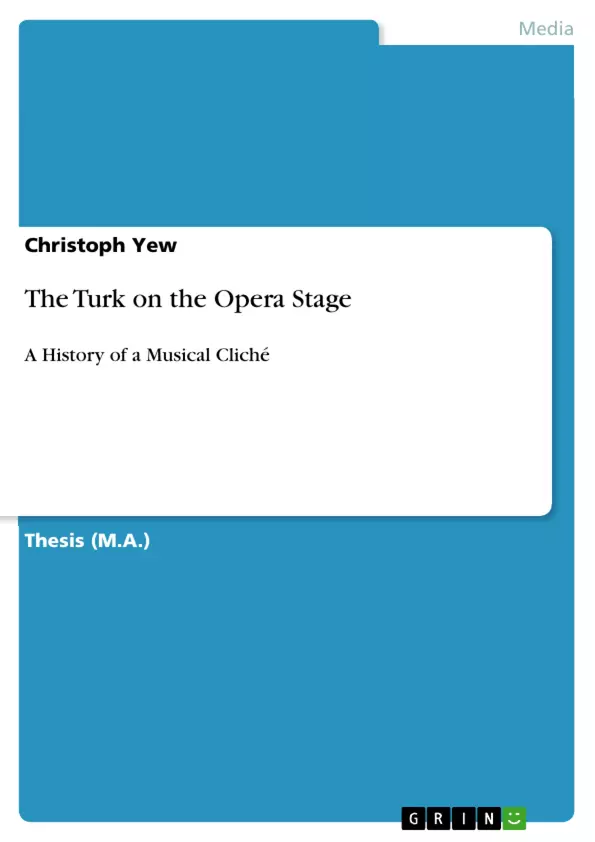
The Turk on the Opera Stage
Magisterarbeit, 2009
117 Seiten, Note: 2.0
Leseprobe
Table of Contents
- 1. Introduction
- 2. The Turks
- 2.1 Historical Overview
- 2.1.1 Rise of the Ottoman Empire
- 2.1.2 and Fall of the Ottoman Empire
- 2.2 The Opinion of Europeans
- 2.1 Historical Overview
- 3. Turkish Music and its Imitations
- 3.1 Military Music
- 3.1.1 Janissary Music
- 3.1.1.1 Instrumentation
- 3.1.1.2 Music
- 3.1.1.3 Reception
- 3.1.2 Alla Turca Style
- 3.1.1 Janissary Music
- 3.2 Other Styles
- 3.3 After the late 18th Century
- 3.1 Military Music
- 4. Overview of Operas
- 4.1 Italian
- 4.2 French
- 4.3 English
- 4.4 German
- 4.5 Interim Results
- 5. "Opera-Turks" in Detail
- 5.1 Monarchs
- 5.2 Guards and Henchmen
- 5.3 Funny and Stupid Turks
- 5.4 Women
- 5.5 Miscellaneous Elements
- 5.6 Résumé
Objectives and Key Themes
This thesis aims to analyze the portrayal of Turks in Western European operas, examining how their roles and characterizations evolved over time. The study investigates the influence of historical events and perceptions of Turkish culture on the musical and dramatic representations of Turks on the opera stage.
- The historical context of European-Ottoman relations and its impact on operatic portrayals of Turks.
- The development and use of "Turkish" musical styles in Western European operas.
- The stereotypical characterizations of Turks in opera, including their roles as monarchs, soldiers, and comedic figures.
- The evolution of these stereotypes over time and across different national opera traditions.
- The relationship between musical style and character portrayal in depicting Turks on the opera stage.
Chapter Summaries
1. Introduction: This introductory chapter sets the stage for the thesis by establishing the historical context of European-Ottoman relations, beginning with their first major military confrontation in 1389. It highlights the long history of conflict and the resulting negative stereotypes of Turks in European minds. The chapter then introduces the use of "exotic" elements, including Turkish themes, in European operas, suggesting that the fear and fascination with the Turks fueled their inclusion in operatic productions. Finally, the chapter outlines the thesis's central questions concerning the portrayal of Turks in opera, their changing characterizations over time, and the identification of significant trends in their representation.
2. The Turks: This chapter provides a historical overview of the Ottoman Empire, discussing its rise and fall, and then explores how Europeans perceived the Ottoman Empire and its people throughout history. It details how these perceptions – often shaped by military conflicts and political anxieties – influenced the eventual portrayal of Turks in Western European art, including opera. The chapter sets the groundwork for understanding the cultural baggage associated with the image of "the Turk" which would shape artistic representations.
3. Turkish Music and its Imitations: This chapter delves into the incorporation of Turkish musical elements into Western European music, focusing particularly on military music, such as Janissary music, and its stylistic adaptation known as "alla turca." It analyzes the instrumentation, musical characteristics, and reception of these styles, tracing their evolution and influence on the creation of "Turkish" musical identities within operatic compositions. The chapter explores how these musical elements contributed to the creation of specific on-stage characters and atmospheres, shaping the overall perception of "Turkishness" in operas.
4. Overview of Operas: This chapter offers a comparative overview of how "Turkish" characters and themes were presented in operas from various European countries (Italian, French, English, and German). By providing a broad survey across national traditions, this section sets the context for a deeper examination of specific operatic works and their unique portrayals of Turks in subsequent chapters. This overview highlights both commonalities and differences in the depiction of Turks within different national operatic styles.
5. "Opera-Turks" in Detail: This chapter presents a detailed analysis of various "Turkish" character types that frequently appeared in Western European operas. It examines the representation of monarchs, guards, comical characters, and female figures, providing specific examples from various operas to illustrate the distinct roles and stereotypes associated with each type. This chapter moves beyond a general survey to provide in-depth analyses of specific characterizations, demonstrating how composers employed both musical and dramatic elements to reinforce pre-existing perceptions of Turks.
Keywords
Opera, Turkish music, Ottoman Empire, stereotypes, cultural exchange, musical clichés, Janissary music, alla turca, character portrayal, historical context, European perceptions.
Frequently Asked Questions: Analysis of the Portrayal of Turks in Western European Operas
What is the main topic of this thesis?
This thesis analyzes how Turks were portrayed in Western European operas, examining the evolution of their roles and characterizations over time. It investigates the impact of historical events and perceptions of Turkish culture on these operatic representations.
What are the key themes explored in this thesis?
The thesis explores the historical context of European-Ottoman relations and its influence on operatic portrayals of Turks; the development and use of "Turkish" musical styles in Western European operas; the stereotypical characterizations of Turks (monarchs, soldiers, comedic figures); the evolution of these stereotypes across different national opera traditions; and the relationship between musical style and character portrayal in depicting Turks on the opera stage.
What is covered in the introduction chapter?
The introduction sets the historical context of European-Ottoman relations, highlighting the long history of conflict and resulting negative stereotypes. It introduces the use of "exotic" elements, including Turkish themes, in European operas, and outlines the thesis's central questions regarding the portrayal of Turks in opera.
What does the chapter on "The Turks" discuss?
This chapter provides a historical overview of the Ottoman Empire's rise and fall and explores how Europeans perceived the Ottoman Empire and its people. It details how these perceptions influenced the portrayal of Turks in Western European art, including opera.
What is the focus of the chapter on "Turkish Music and its Imitations"?
This chapter examines the incorporation of Turkish musical elements into Western European music, particularly focusing on military music like Janissary music and "alla turca." It analyzes their instrumentation, musical characteristics, and reception, and how these elements contributed to the creation of specific on-stage characters and atmospheres.
What does the chapter on "Overview of Operas" cover?
This chapter offers a comparative overview of how "Turkish" characters and themes were presented in Italian, French, English, and German operas, highlighting both commonalities and differences in their depiction within different national operatic styles.
What is detailed in the chapter on ""Opera-Turks" in Detail"?
This chapter provides a detailed analysis of various "Turkish" character types frequently appearing in Western European operas. It examines the representation of monarchs, guards, comical characters, and female figures, providing specific examples from various operas.
What are the keywords associated with this thesis?
Opera, Turkish music, Ottoman Empire, stereotypes, cultural exchange, musical clichés, Janissary music, alla turca, character portrayal, historical context, European perceptions.
What is the overall structure of the provided document?
The document presents a comprehensive preview of a thesis, including a table of contents, objectives and key themes, chapter summaries, and keywords. It offers a structured overview of the research and its findings.
What is the intended audience for this document?
This document appears intended for academic use, providing a structured overview of a thesis for researchers or those interested in the topic of the portrayal of Turks in Western European operas.
Details
- Titel
- The Turk on the Opera Stage
- Untertitel
- A History of a Musical Cliché
- Hochschule
- Universität Osnabrück (Musikwissenschaft)
- Note
- 2.0
- Autor
- Dipl.-Kfm., Mag. art. Christoph Yew (Autor:in)
- Erscheinungsjahr
- 2009
- Seiten
- 117
- Katalognummer
- V141533
- ISBN (eBook)
- 9783640509232
- ISBN (Buch)
- 9783640509546
- Dateigröße
- 1592 KB
- Sprache
- Englisch
- Schlagworte
- Musicology Turks Opera
- Produktsicherheit
- GRIN Publishing GmbH
- Preis (Ebook)
- US$ 40,99
- Preis (Book)
- US$ 52,99
- Arbeit zitieren
- Dipl.-Kfm., Mag. art. Christoph Yew (Autor:in), 2009, The Turk on the Opera Stage, München, Page::Imprint:: GRINVerlagOHG, https://www.diplomarbeiten24.de/document/141533
- Autor werden
- Ihre Optionen
- Vertriebskanäle
- Premium Services
- Autorenprofil
- Textarten und Formate
- Services für Verlage, Hochschulen, Unternehmen

- © GRIN Publishing GmbH.
- Alle Inhalte urheberrechtlich geschützt. Kopieren und verbreiten untersagt.
- info@grin.com
- AGB
- Open Publishing
Der GRIN Verlag hat sich seit 1998 auf die Veröffentlichung akademischer eBooks und Bücher spezialisiert. Der GRIN Verlag steht damit als erstes Unternehmen für User Generated Quality Content. Die Verlagsseiten GRIN.com, Hausarbeiten.de und Diplomarbeiten24 bieten für Hochschullehrer, Absolventen und Studenten die ideale Plattform, wissenschaftliche Texte wie Hausarbeiten, Referate, Bachelorarbeiten, Masterarbeiten, Diplomarbeiten, Dissertationen und wissenschaftliche Aufsätze einem breiten Publikum zu präsentieren.
Kostenfreie Veröffentlichung: Hausarbeit, Bachelorarbeit, Diplomarbeit, Dissertation, Masterarbeit, Interpretation oder Referat jetzt veröffentlichen!
- GRIN Verlag GmbH
-
- Nymphenburger Str. 86
- 80636
- Munich, Deutschland
- +49 89-550559-0
- +49 89-550559-10
- info@grin.com
-









